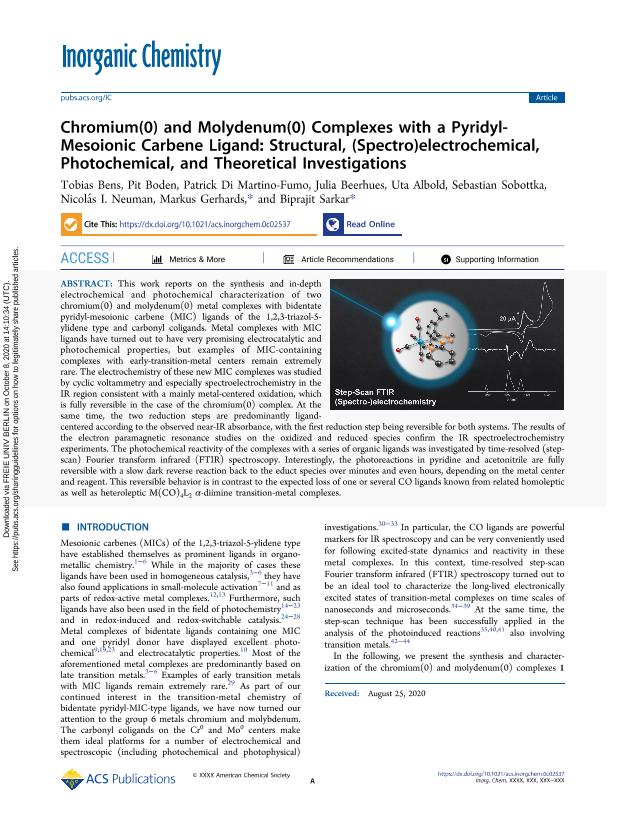Mostrar el registro sencillo del ítem
dc.contributor.author
Bens, Tobias
dc.contributor.author
Boden, Pit
dc.contributor.author
Di Martino-Fumo, Patrick
dc.contributor.author
Beerhues, Julia
dc.contributor.author
Albold, Uta
dc.contributor.author
Sobottka, Sebastian
dc.contributor.author
Neuman, Nicolás Ignacio

dc.contributor.author
Gerhards, Markus
dc.contributor.author
Sarkar, Biprajit
dc.date.available
2020-10-31T20:58:16Z
dc.date.issued
2020-10
dc.identifier.citation
Bens, Tobias; Boden, Pit; Di Martino-Fumo, Patrick; Beerhues, Julia; Albold, Uta; et al.; Chromium(0) and Molydenum(0) Complexes with a Pyridyl-Mesoionic Carbene Ligand: Structural, (Spectro)electrochemical, Photochemical, and Theoretical Investigations; American Chemical Society; Inorganic Chemistry; 59; 20; 10-2020; 15504-15513
dc.identifier.issn
0020-1669
dc.identifier.uri
http://hdl.handle.net/11336/117348
dc.description.abstract
This work reports on the synthesis and in-depth electrochemical and photochemical characterization of two chromium(0) and molydenum(0) metal complexes with bidentate pyridyl-mesoionic carbene (MIC) ligands of the 1,2,3-triazol-5-ylidene type and carbonyl coligands. Metal complexes with MIC ligands have turned out to have very promising electrocatalytic and photochemical properties, but examples of MIC-containing complexes with early-transition-metal centers remain extremely rare. The electrochemistry of these new MIC complexes was studied by cyclic voltammetry and especially spectroelectrochemistry in the IR region consistent with a mainly metal-centered oxidation, which is fully reversible in the case of the chromium(0) complex. At the same time, the two reduction steps are predominantly ligand-centered according to the observed near-IR absorbance, with the first reduction step being reversible for both systems. The results of the electron paramagnetic resonance studies on the oxidized and reduced species confirm the IR spectroelectrochemistry experiments. The photochemical reactivity of the complexes with a series of organic ligands was investigated by time-resolved (step-scan) Fourier transform infrared (FTIR) spectroscopy. Interestingly, the photoreactions in pyridine and acetonitrile are fully reversible with a slow dark reverse reaction back to the educt species over minutes and even hours, depending on the metal center and reagent. This reversible behavior is in contrast to the expected loss of one or several CO ligands known from related homoleptic as well as heteroleptic M(CO)4L2 α-diimine transition-metal complexes.
dc.format
application/pdf
dc.language.iso
eng
dc.publisher
American Chemical Society

dc.rights
info:eu-repo/semantics/openAccess
dc.rights.uri
https://creativecommons.org/licenses/by-nc-sa/2.5/ar/
dc.subject
MIC
dc.subject
CHROMIUM
dc.subject
MOLYBDENUM
dc.subject.classification
Química Inorgánica y Nuclear

dc.subject.classification
Ciencias Químicas

dc.subject.classification
CIENCIAS NATURALES Y EXACTAS

dc.title
Chromium(0) and Molydenum(0) Complexes with a Pyridyl-Mesoionic Carbene Ligand: Structural, (Spectro)electrochemical, Photochemical, and Theoretical Investigations
dc.type
info:eu-repo/semantics/article
dc.type
info:ar-repo/semantics/artículo
dc.type
info:eu-repo/semantics/publishedVersion
dc.date.updated
2020-10-19T16:16:53Z
dc.journal.volume
59
dc.journal.number
20
dc.journal.pagination
15504-15513
dc.journal.pais
Estados Unidos

dc.description.fil
Fil: Bens, Tobias. Universitat Stuttgart; Alemania
dc.description.fil
Fil: Boden, Pit. Freie Universität Berlin; Alemania
dc.description.fil
Fil: Di Martino-Fumo, Patrick. Freie Universität Berlin; Alemania
dc.description.fil
Fil: Beerhues, Julia. Universitat Stuttgart; Alemania
dc.description.fil
Fil: Albold, Uta. Freie Universität Berlin; Alemania
dc.description.fil
Fil: Sobottka, Sebastian. Universitat Stuttgart; Alemania
dc.description.fil
Fil: Neuman, Nicolás Ignacio. Consejo Nacional de Investigaciones Científicas y Técnicas. Centro Científico Tecnológico Conicet - Santa Fe. Instituto de Desarrollo Tecnológico para la Industria Química. Universidad Nacional del Litoral. Instituto de Desarrollo Tecnológico para la Industria Química; Argentina
dc.description.fil
Fil: Gerhards, Markus. Freie Universität Berlin; Alemania
dc.description.fil
Fil: Sarkar, Biprajit. Universitat Stuttgart; Alemania
dc.journal.title
Inorganic Chemistry

dc.relation.alternativeid
info:eu-repo/semantics/altIdentifier/url/https://pubs.acs.org/doi/10.1021/acs.inorgchem.0c02537
dc.relation.alternativeid
info:eu-repo/semantics/altIdentifier/doi/http://dx.doi.org/10.1021/acs.inorgchem.0c02537
Archivos asociados
